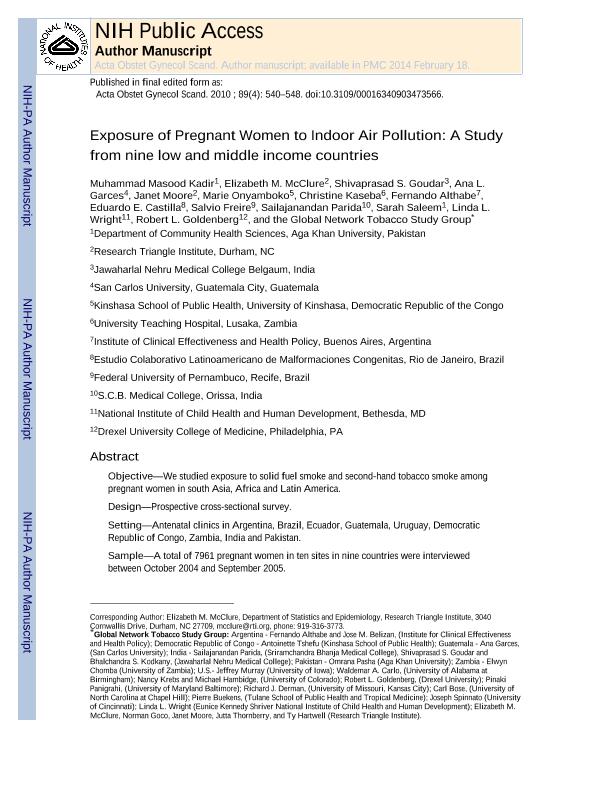Artículo
Exposure of pregnant women to indoor air pollution: a study from nine low and middle income countries
Kadir, Muhammad Masood; McClure, Elizabeth M.; Goudar, Shivaprasad S.; Garces, Ana L.; Moore, Janet; Onyamboko, Marie; Kaseba, Christine; Althabe, Fernando ; Castilla, Eduardo Enrique
; Castilla, Eduardo Enrique ; Freire, Salvio; Parida, Sailajanandan; Saleem, Sarah; Wright, Linda L.; Goldenberg, Robert L.; Global Network Tobacco Study Group
; Freire, Salvio; Parida, Sailajanandan; Saleem, Sarah; Wright, Linda L.; Goldenberg, Robert L.; Global Network Tobacco Study Group
 ; Castilla, Eduardo Enrique
; Castilla, Eduardo Enrique ; Freire, Salvio; Parida, Sailajanandan; Saleem, Sarah; Wright, Linda L.; Goldenberg, Robert L.; Global Network Tobacco Study Group
; Freire, Salvio; Parida, Sailajanandan; Saleem, Sarah; Wright, Linda L.; Goldenberg, Robert L.; Global Network Tobacco Study Group
Fecha de publicación:
01/2010
Editorial:
Taylor & Francis As
Revista:
Acta obstetricia et gynecologica Scandinavica
ISSN:
0001-6349
Idioma:
Inglés
Tipo de recurso:
Artículo publicado
Clasificación temática:
Resumen
OBJECTIVE: We studied exposure to solid fuel and second-hand tobacco smoke among pregnant women in south Asia, Africa and Latin America. DESIGN: Prospective cross-sectional survey. SETTING: Antenatal clinics in Argentina, Brazil, Ecuador, Guatemala, Uruguay, Democratic Republic of Congo, Zambia, India and Pakistan. SAMPLE: A total of 7,961 pregnant women in ten sites in nine countries were interviewed between October 2004 and September 2005. METHODS: A standardized questionnaire on exposure to indoor air pollution (IAP) and second-hand smoke was administered to pregnant women during antenatal care. MAIN OUTCOME MEASURES: Exposure to IAP and second-hand tobacco smoke. RESULTS: South Asian pregnant women commonly reported use of wood (49.1-89.7%), crop residue and animal dung as cooking and heating fuel. African pregnant women reported higher use of charcoal (85.4-93.5%). Latin American pregnant women had greater use of petroleum gas. Among south Asian women, solid fuel use and cooking on an open flame inside the home were common. There was a significant association between solid fuel use and allowing smoking within the home at the Asian sites and in Zambia (p < 0.05). CONCLUSIONS: Pregnant women from low/middle income countries were commonly exposed to IAP secondary to use of solid fuels. Among these populations, exposure to second-hand tobacco smoke was also common. This combination of exposures likely increases the risk of poor pregnancy outcomes among the most vulnerable women. Our study highlights the importance of further research on the combined impact of IAP and second-hand tobacco smoke exposures on adverse maternal and perinatal outcomes.
Palabras clave:
Indoor Air Pollution
Archivos asociados
Licencia
Identificadores
Colecciones
Articulos(SEDE CENTRAL)
Articulos de SEDE CENTRAL
Articulos de SEDE CENTRAL
Citación
Kadir, Muhammad Masood; McClure, Elizabeth M.; Goudar, Shivaprasad S.; Garces, Ana L.; Moore, Janet; et al.; Exposure of pregnant women to indoor air pollution: a study from nine low and middle income countries; Taylor & Francis As; Acta obstetricia et gynecologica Scandinavica; 89; 4; 1-2010; 540-548
Compartir
Altmétricas



